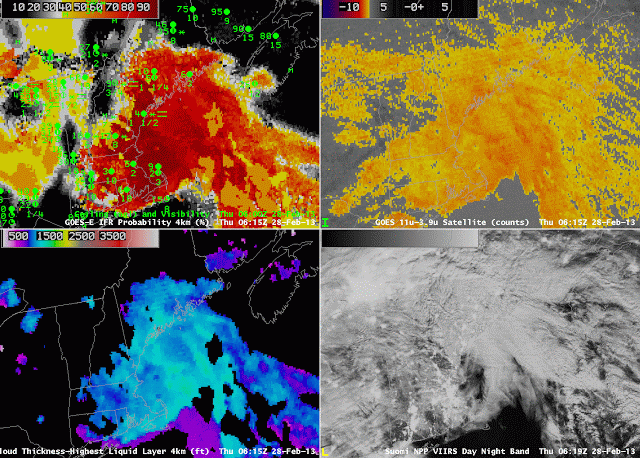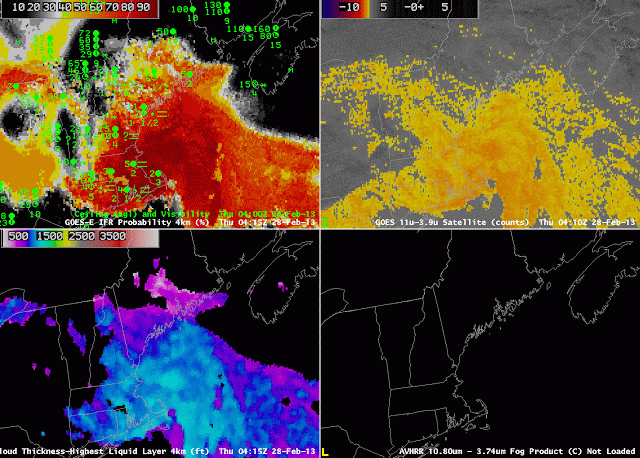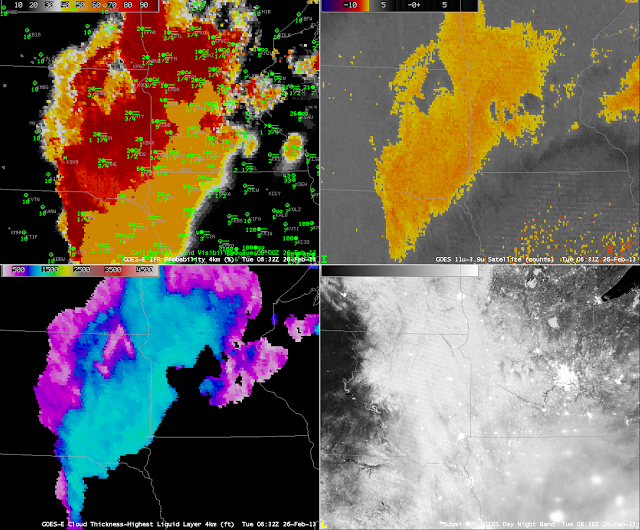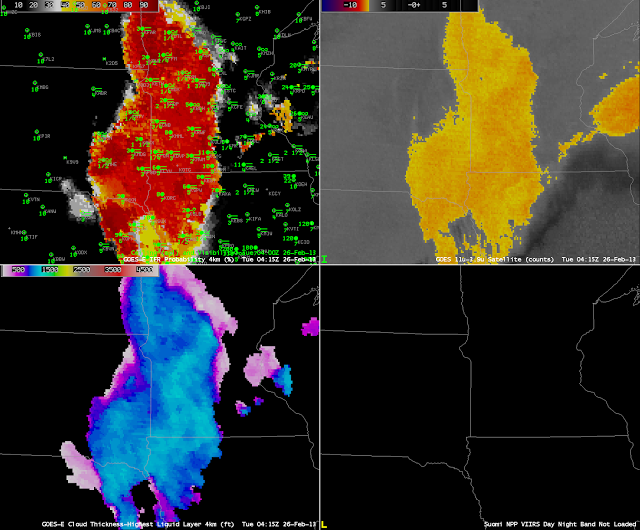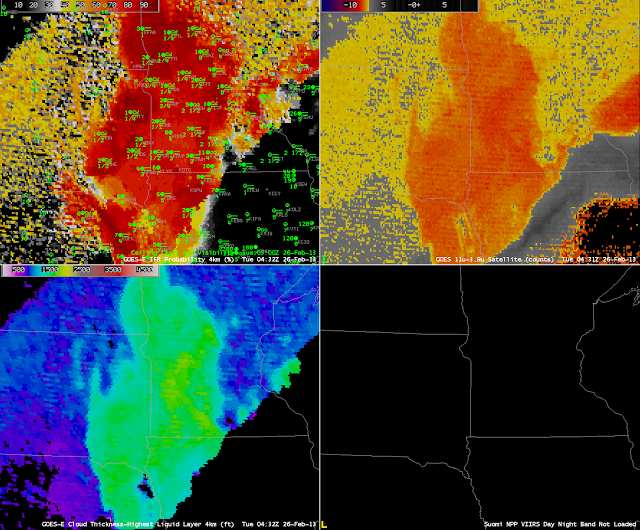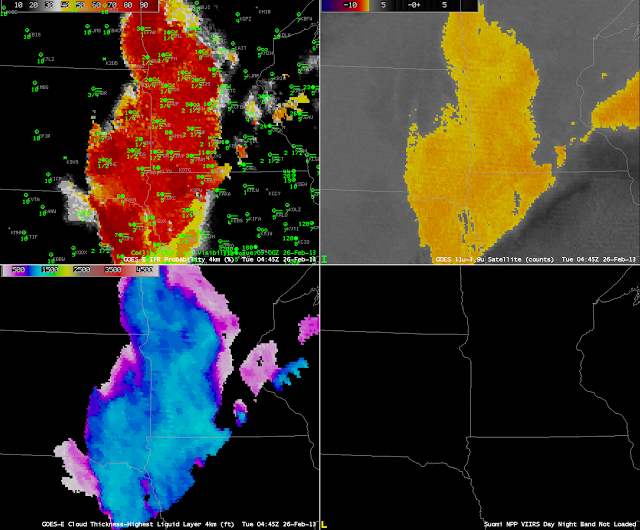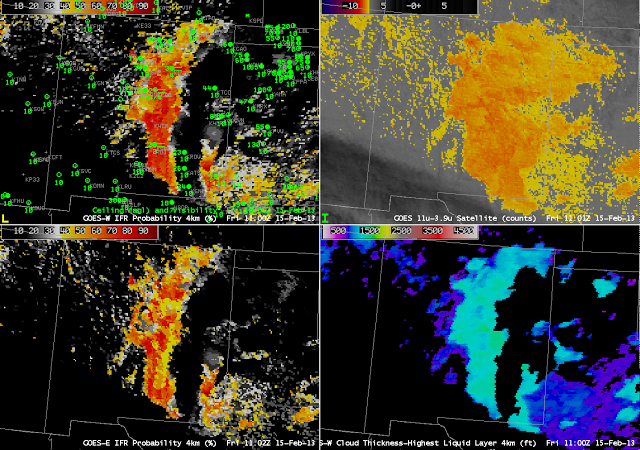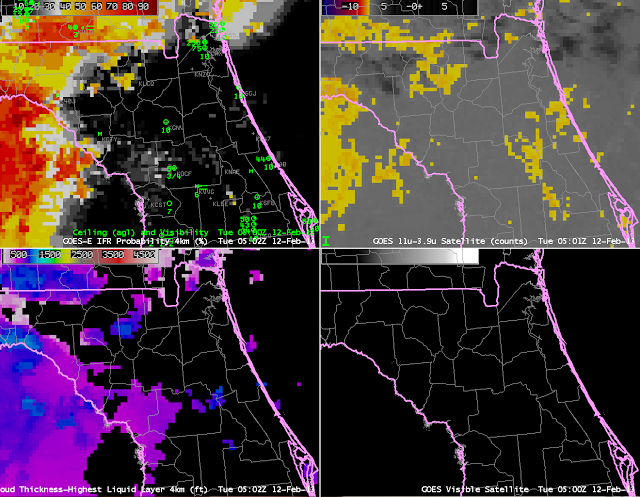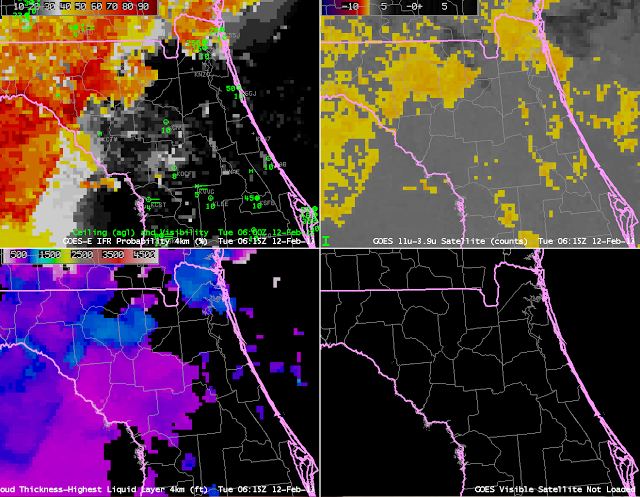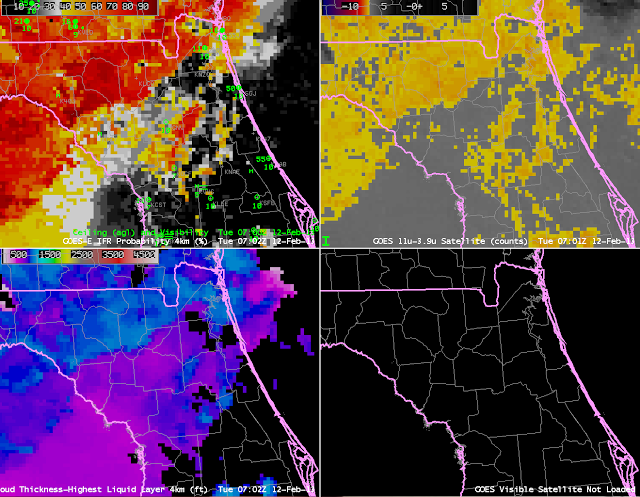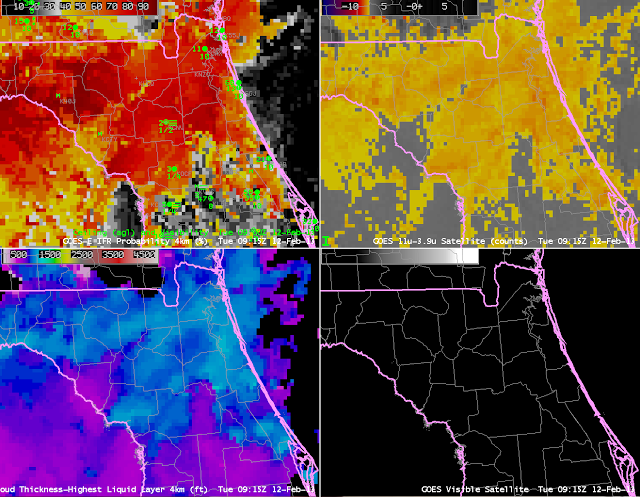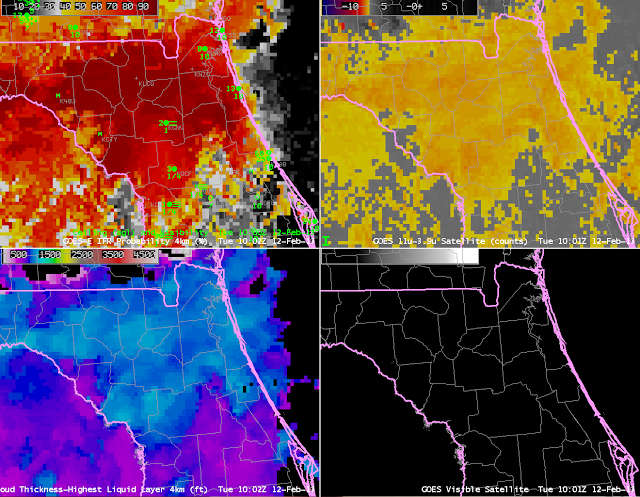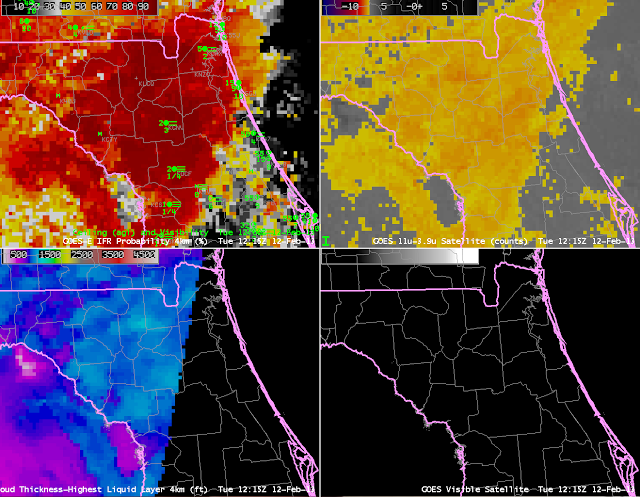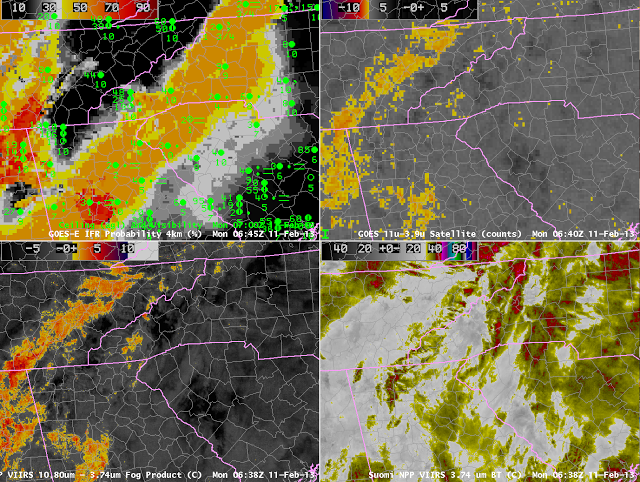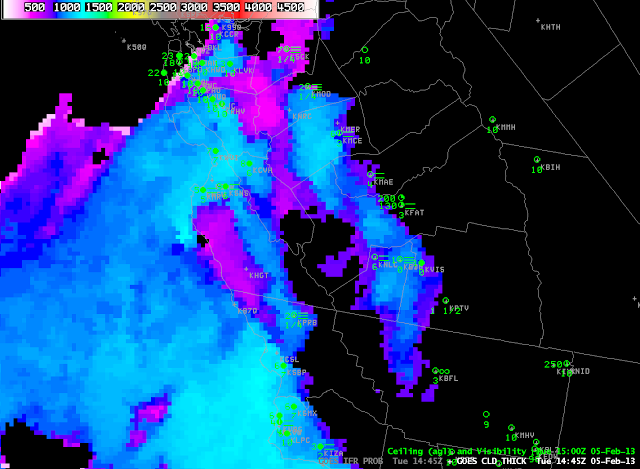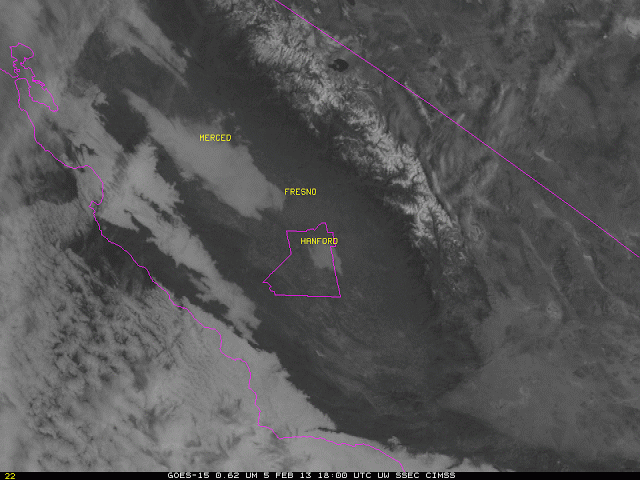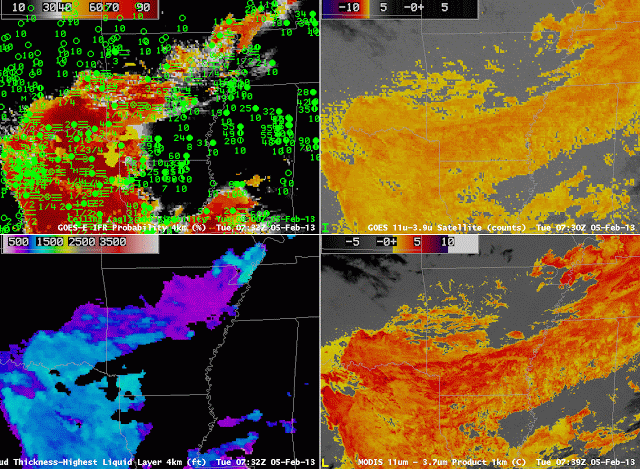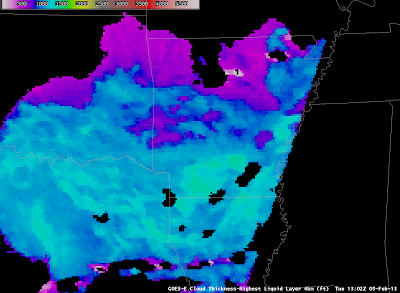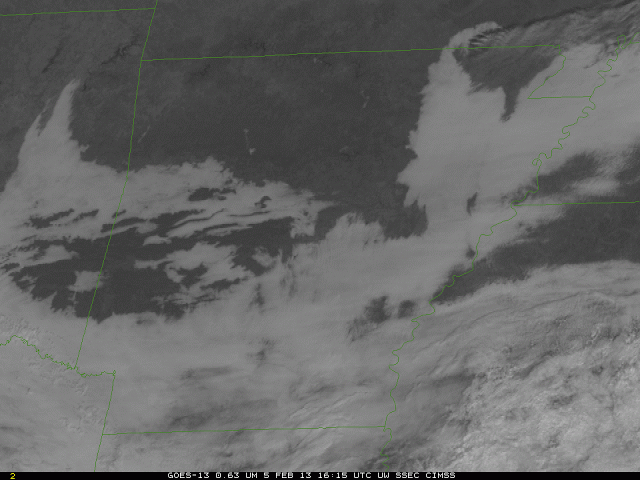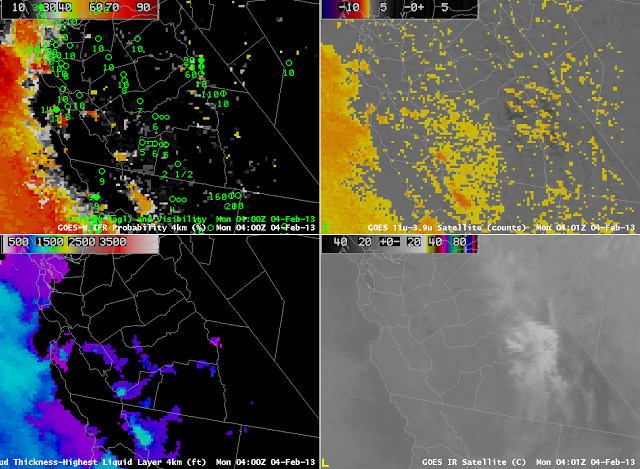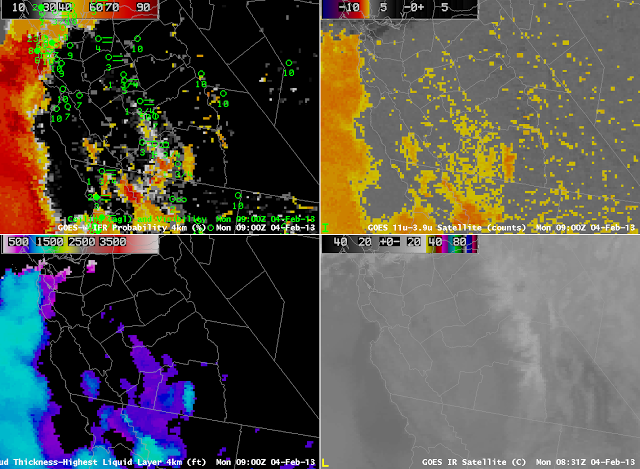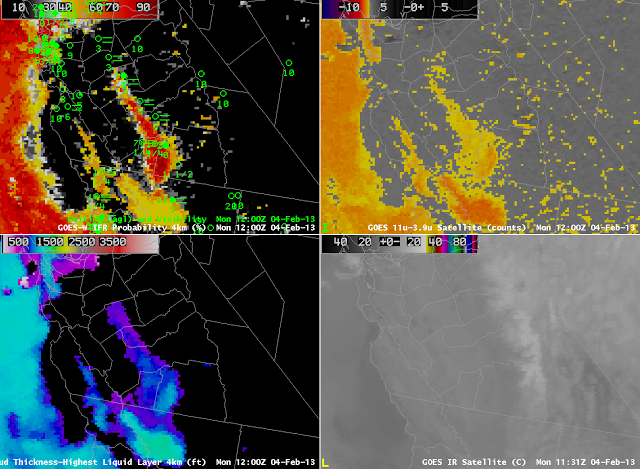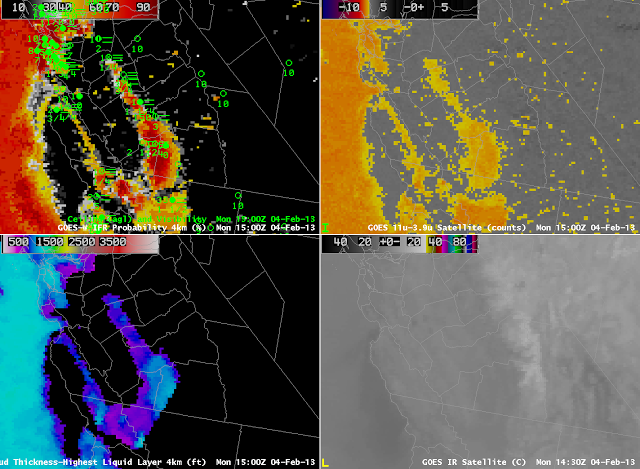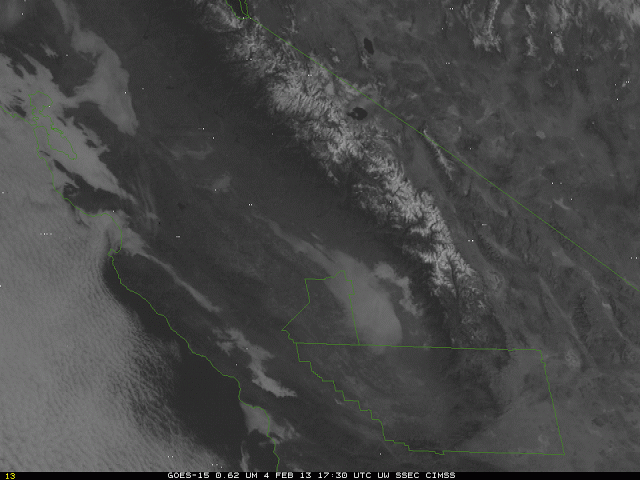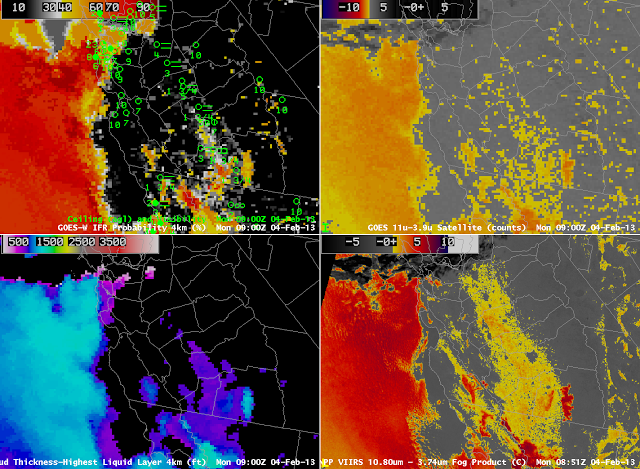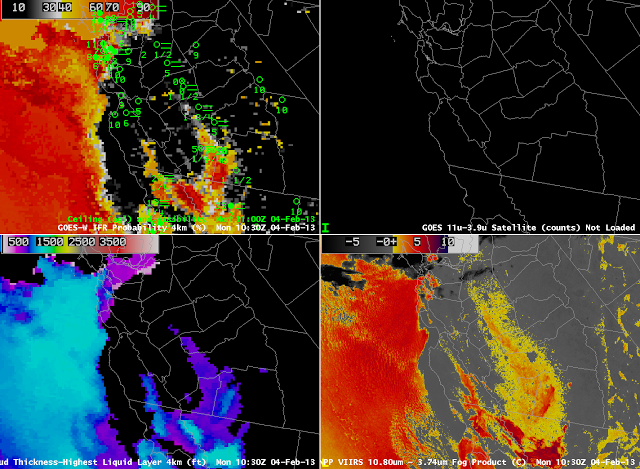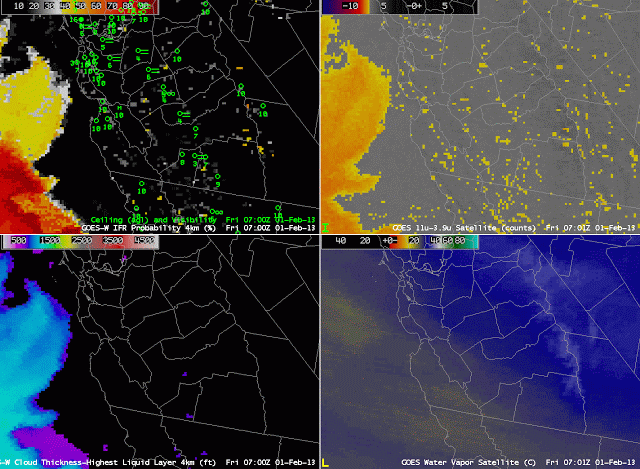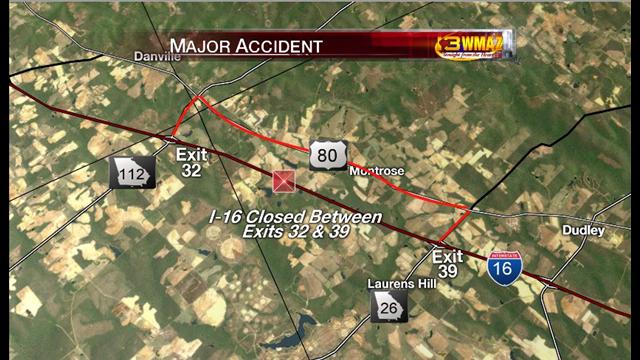 |
| Map of Crash Location, courtesy WMAZ TV in Macon, Georgia |
A multi-vehicle accident with fatalities occurred in extreme western Laurens County in central Georgia early Wednesday Morning, 6 February 2013. (According to this news report, the first crash was around 1310 UTC) Was fog a factor in this accident? Fog was reported in and around the scene as first responders arrived.
Laurens County is in the Peachtree City CWA, and the relevant part of the Forecast Discussion at 0000 UTC is as follows:
000
FXUS62 KFFC 060007
AFDFFC
AREA FORECAST DISCUSSION...UPDATED FOR AVIATION
NATIONAL WEATHER SERVICE PEACHTREE CITY GA
ISSUED BY NATIONAL WEATHER SERVICE BIRMINGHAM AL
705 PM EST TUE FEB 5 2013
.SHORT TERM /TONIGHT THROUGH WEDNESDAY NIGHT/...
FAIRLY QUIET WEATHER THROUGH THE SHORT TERM PERIOD. A WEAK
SHORTWAVE HAS BROUGHT A BAND OF CLOUDS TO THE AREA AND A FEW
SPRINKLES SHOW UP EVERY NOW AND THEN ON RADAR. CLOUDS ARE EXPECTED
TO THIN OUT OVERNIGHT AND FOG COULD BECOME AN ISSUE IN THE FEW
HOURS BEFORE SUNRISE. THIS IS SOMETHING THAT WILL HAVE TO BE
MONITORED THROUGH THE EVENING. MILD TEMPERATURES THROUGH THE
PERIOD.
.LONG TERM /THURSDAY THROUGH TUESDAY/...
[...snipped...]
&&
.AVIATION... 00Z TAF DISCUSSION.
VFR CIGS WILL CONTINUE ACROSS THE TAF SITES THIS EVENING.
EXPECT MVFR CONDITIONS LATE TONIGHT AS FOG AND LOW CLOUDS DEVELOP
BEGINNING AFTER 06Z NEAR CSG SPREADING NORTH AND EAST. THE ATLANTA
TAF SITES SHOULD EXPECT TO BE IMPACTED BY 08-09Z. IMPROVING
CONDITIONS BY 15Z. LIGHT WESTERLY WINDS EXPECTED.
So, overnight fog was considered a possibility at 0000 UTC.
And updated AFD was issued shortly before 0600 UTC. In that update the Aviation discussion was tweaked:
FXUS62 KFFC 060553
AFDFFC
AREA FORECAST DISCUSSION...UPDATED FOR AVIATION
NATIONAL WEATHER SERVICE PEACHTREE CITY GA
ISSUED BY NATIONAL WEATHER SERVICE BIRMINGHAM AL
1245 AM EST WED FEB 6 2013
.SHORT TERM /TONIGHT THROUGH WEDNESDAY NIGHT/...
[...no changes...]
.LONG TERM /THURSDAY THROUGH TUESDAY/...
[...snipped for brevity...]
&&
.AVIATION... 06Z TAF DISCUSSION.
PATCHY CEILINGS BKN030-040 LINGERING THROUGH THE NIGHT. POTENTIAL
FOR LIFR CONDITIONS WHERE SKIES ARE CLEAR...BUT EXPECT ALL TAF SITES
TO HAVE AT LEAST MVFR CONDITIONS 08Z THROUGH 14Z. IMPROVING AFTER
THAT TO VFR. WINDS NORTHWEST 5 TO 10KT AFTER 15Z.
//ATL CONFIDENCE...06Z UPDATE...
MEDIUM CONFIDENCE ON ALL ELEMENTS.
Note that a mention of LIFR conditions has appeared in the Aviation Discussion. What did the GOES-R IFR Probability show between 0000 and 0600 UTC?
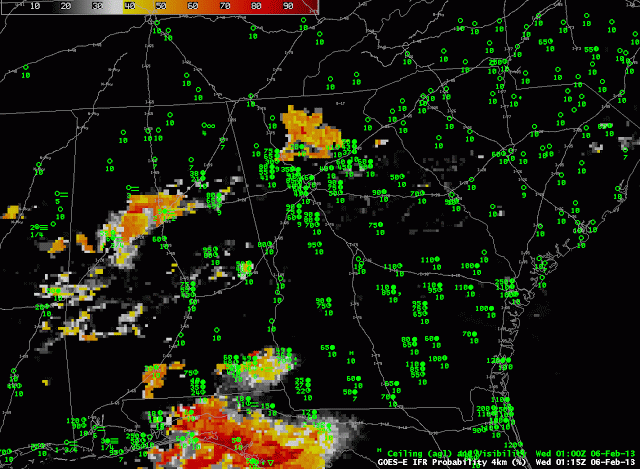 |
| GOES-R IFR Probabilities computed from GOES-East and Rapid Refresh Data, 0115 through 0515 UTC 6 February, along with hourly observations of ceilings/visibility |
Especially in the last two hours — 0415 and 0515 UTC — there is a general expansion in high probabilities from west to east across southern Georgia, with probabilities increasing north of I-16. By 0815 UTC, below, IFR conditions are being reported at many locations in northwest Georgia, and IFR probabilities continue to increase over east-central Georgia.
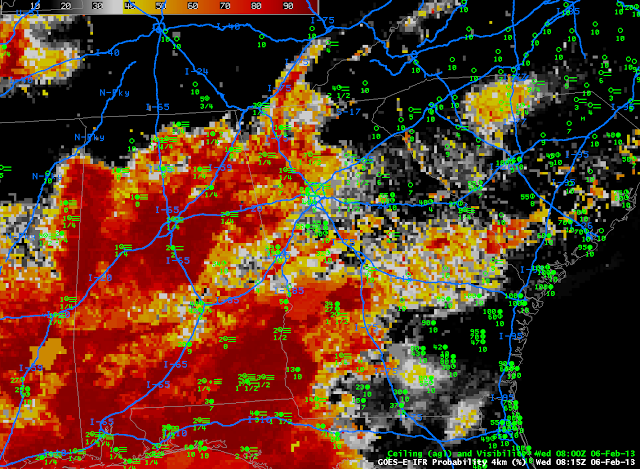 |
| As in the loop above, but for 0815 UTC only. Interstate Highways are denoted in Blue. |
The AFD issued at 0930 coincided with the issuance of a dense fog advisory (highlighted in
red) for most of the CWA:
000
FXUS62 KFFC 060930
AFDFFC
AREA FORECAST DISCUSSION
NATIONAL WEATHER SERVICE PEACHTREE CITY GA
430 AM EST WED FEB 6 2013
.SHORT TERM /TODAY THROUGH THURSDAY NIGHT/...
SOME LOW LEVEL MOISTURE REMAINING THIS MORNING AND THIS HAS PRODUCED
FOG ACROSS MANY AREAS. WILL GO AHEAD AND ISSUE A DENSE FOG ADVISORY
SINCE MOST PLACES SEEM TO BE HEADED FOR VERY LOW VISIBILITY.
OTHERWISE DRY HIGH PRESSURE BUILDING OVER THE SOUTHEAST TODAY AND
MOVING OFF THE ATLANTIC COAST TONIGHT. NEXT SHORT WAVE COMING ACROSS
THE NORTHERN GULF SHOULD BEGIN TO AFFECT OUR CWA MAINLY 06Z THURSDAY
AND BEYOND. THIS SOUTHERN STREAM SYSTEM MOVES ACROSS THE STATE
THURSDAY AND THURSDAY NIGHT WITH SOME DIFFERENCES BETWEEN MODELS
WITH LOCATION AND STRENGTH OF SURFACE LOW. IN GENERAL...LOOKS LIKE A
WEDGE SETTING UP LATE TONIGHT INTO THURSDAY WITH MUCH OF THE CWA IN
EASTERLY FLOW. THERE SHOULD BE A SHARP GRADIENT OF TEMPERATURES
BETWEEN NORTH AND CENTRAL ZONES AND FOR NOW HAVE KEPT THE WARMER AIR
ON THURSDAY CONFINED TO COLUMBUS TO MACON AND SOUTH. CATEGORICAL
POPS FOR THURSDAY TAPERING OFF WEST TO EAST THURSDAY NIGHT AS THE
SURFACE LOW MOVES EAST. NO MENTION OF THUNDER AS WEDGE SHOULD BE
STABLE. HOWEVER SOME INSTABILITY COULD PUSH INTO THE CENTRAL ZONES
THURSDAY AFTERNOON ALONG THE BOUNDARY.
41
.LONG TERM /FRIDAY THROUGH TUESDAY/...
[...snipped...]
01
&&
.AVIATION...
06Z TAF DISCUSSION.
PATCHY CEILINGS BKN030-040 LINGERING THROUGH THE NIGHT. POTENTIAL
FOR LIFR CONDITIONS WHERE SKIES ARE CLEAR...BUT EXPECT ALL TAF
SITES TO HAVE AT LEAST MVFR CONDITIONS 08Z THROUGH 14Z. IMPROVING
AFTER THAT TO VFR. WINDS NORTHWEST 5 TO 10KT AFTER 15Z.
//ATL CONFIDENCE...06Z UPDATE...
MEDIUM CONFIDENCE ON ALL ELEMENTS.
41
&&
.PRELIMINARY POINT TEMPS/POPS...
[...snipped...]
&&
.FFC WATCHES/WARNINGS/ADVISORIES...
DENSE FOG ADVISORY UNTIL 9 AM EST THIS MORNING FOR THE FOLLOWING
ZONES: BALDWIN...BANKS...BARROW...BARTOW...BIBB...BLECKLEY...
BUTTS...CARROLL...CATOOSA...CHATTAHOOCHEE...CHATTOOGA...
CHEROKEE...CLARKE...CLAYTON...COBB...COWETA...CRAWFORD...CRISP...
DADE...DAWSON...DEKALB...DODGE...DOOLY...DOUGLAS...EMANUEL...
FANNIN...FAYETTE...FLOYD...FORSYTH...GILMER...GLASCOCK...
GORDON...GREENE...GWINNETT...HALL...HANCOCK...HARALSON...
HARRIS...HEARD...HENRY...HOUSTON...JACKSON...JASPER...
JEFFERSON...JOHNSON...JONES...LAMAR...LAURENS...LUMPKIN...
MACON...MADISON...MARION...MERIWETHER...MONROE...MONTGOMERY...
MORGAN...MURRAY...MUSCOGEE...NEWTON...NORTH FULTON...OCONEE...
OGLETHORPE...PAULDING...PEACH...PICKENS...PIKE...POLK...
PULASKI...PUTNAM...ROCKDALE...SCHLEY...SOUTH FULTON...SPALDING...
STEWART...SUMTER...TALBOT...TALIAFERRO...TAYLOR...TELFAIR...
TOOMBS...TOWNS...TREUTLEN...TROUP...TWIGGS...UNION...UPSON...
WALKER...WALTON...WARREN...WASHINGTON...WEBSTER...WHEELER...
WHITE...WHITFIELD...WILCOX...WILKES...WILKINSON.
&&
$$
SHORT TERM...41
LONG TERM....01
AVIATION...41
The animation from 0815 UTC through 1315 UTC shows a continued increase in the probabilities over the crash site on I-16. In addition, observations decrease to IFR conditions. Note that at 1315 UTC the switch between nighttime and daytime predictors is present in the image as a southwest to northeast boundary over extreme eastern Georgia. Probabilities are high over the crash site, but by 1415 UTC, they have all but vanished as the fog quickly dissipated at sunrise. This suggests a fog that is not thick, and the GOES-R Cloud Thickness corroborates this assumption (see below)
 |
| As in the loop above, but from 0815 UTC through 1315 UTC. Crash occurred at 1310 UTC |
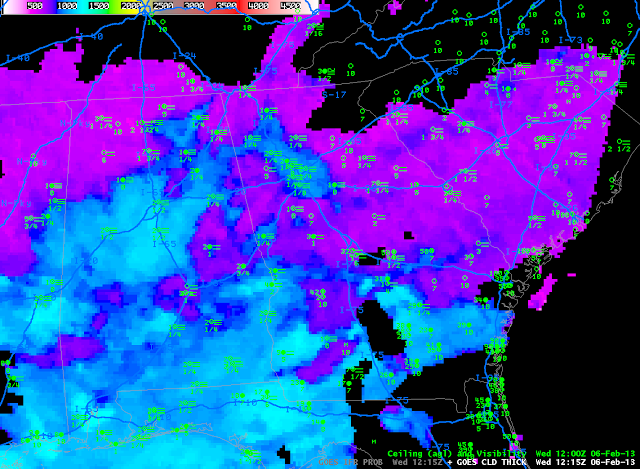 |
| GOES-R Cloud Thickess just before Twilight Conditions, 1215 UTC 6 February. Values near the Crash Site are 600-700 feet. |
The Cloud Thickness field, above, at 1215 UTC, just before twilight conditions, shows values around 600 to 700 feet.
This chart suggests a rapid dissipation time of around 1 hour. Indeed, visible imagery around sunrise shows scant evidence of widespread fog.
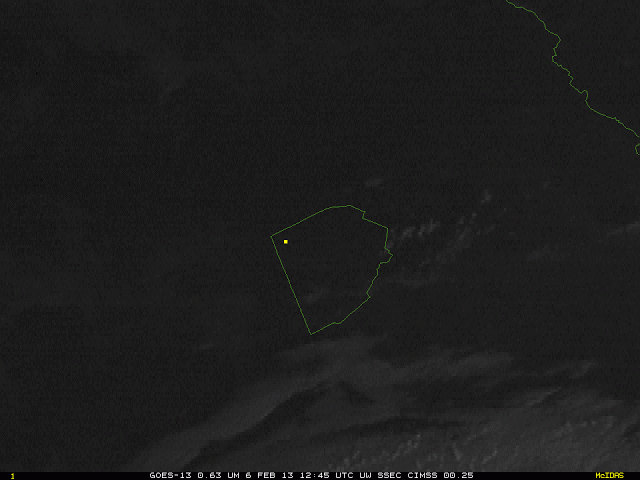 |
| Zoomed-in GOES-13 Visible Imagery over east-central Georgia, times as indicated. Montrose (Yellow square) is indicated within Laurens County (outlined in green) |
Polar orbiters also provide information — at higher spatial resolution — about the evolving situation overnight. Suomi/NPP made two passes over Georgia between 0600 and 0900 UTC, and the brightness temperature difference product that was produced is shown below. There is a noticeable increase in water clouds over Georgia between 0632 UTC and 0811 UTC, the times of the images.
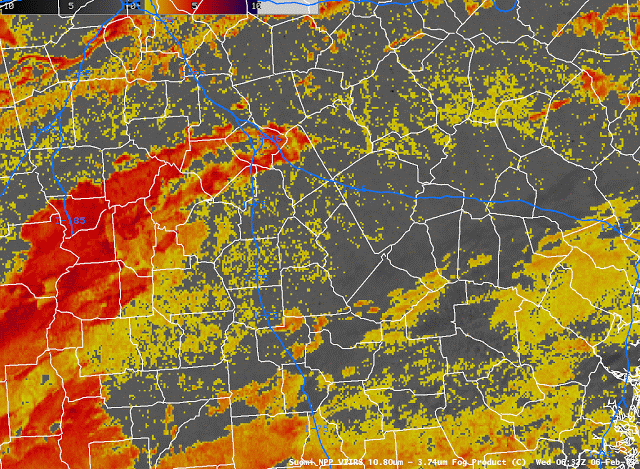 |
| Suomi-NPP Brigthness Temperature Difference (10.80 µm- 3.74 µm) at 0632 UTC and 0811 UTC. Interstate 16 crosses Laurens County near the center of these images. |
MODIS data from Aqua were used to produce IFR probabilities at 0645 UTC, below. This was before the most fog had developed, but it does confirm the picture painted with GOES data’s broader brush: IFR probabilities are increasing over Georgia.
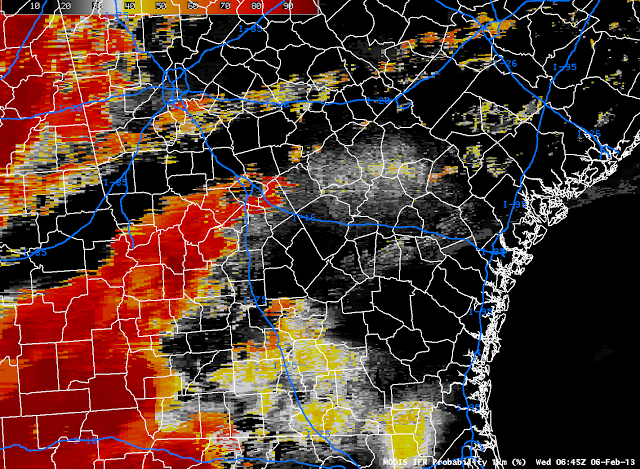 |
| MODIS-based GOES-R IFR Probabilities over Georgia, 0645 UTC on 6 February 2013. |
Finally, AVHRR data from NOAA-15 from 1015 UTC show widespread stratus extending eastnortheast from southwest Georgia to central Georgia.
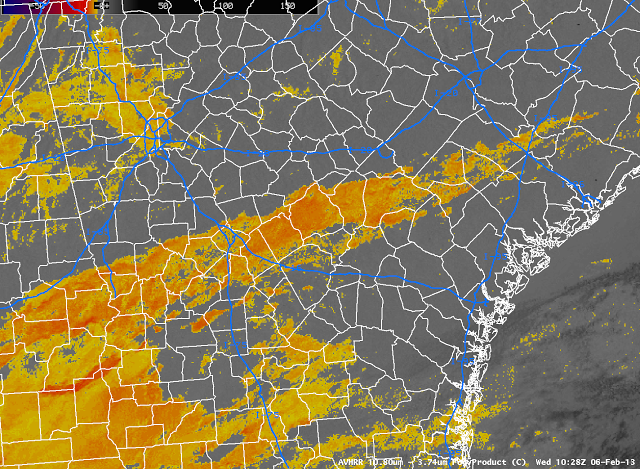 |
| Brightness Temperature Difference (10.8 µm – 3.74 µm) from AVHRR data, 1028 UTC 6 Feb 2013 |

